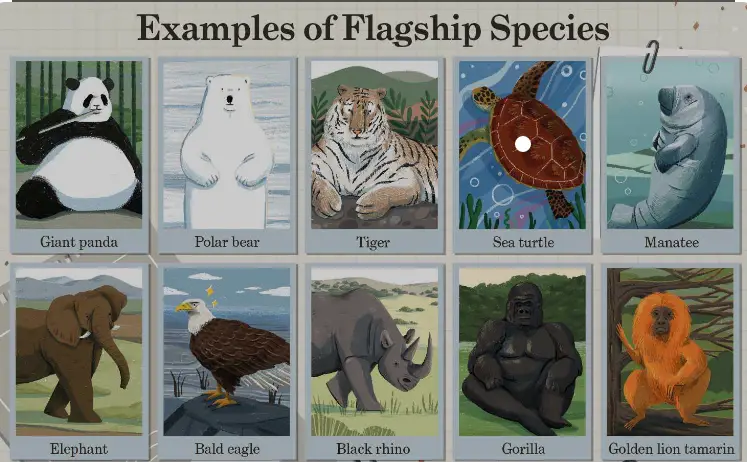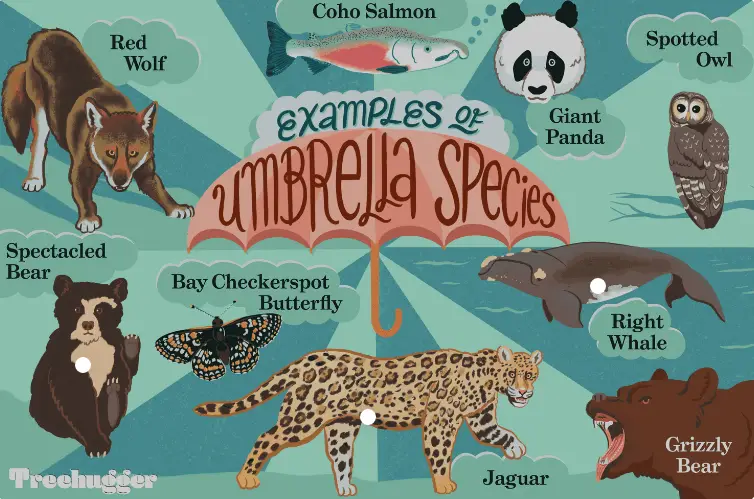Biodiversity conservation is a critical concern for ecologists and environmentalists globally. Amidst a variety of strategies, the concept of flagship and umbrella species stands out due to its direct impact on conservation practices and policy making. These species, though often confused, play distinct roles in the preservation of ecosystems and serve as focal points for raising conservation awareness.
Flagship species are selected primarily for their appealing characteristics to gain public and financial support for conservation projects. Conversely, umbrella species are chosen for their ecological roles; protecting these species inadvertently conserves a wide range of other species within their habitats. This strategic selection ensures broad ecological benefits and fosters comprehensive habitat conservation.
The significance of these species extends beyond their immediate ecological roles. Flagship species often symbolize conservation efforts, drawing attention and funding, while umbrella species offer a practical approach to habitat preservation, ensuring the survival of numerous other species by safeguarding extensive areas of natural habitat.

Flagship Species Defined
Definition and Characteristics
Flagship species are those chosen to act as symbols for habitat conservation efforts, due to their appealing characteristics which capture public interest and foster conservation support. These species are often charismatic, easily recognizable, and can be mammals, birds, or even insects that draw attention and generate empathy from the general public. Their appealing nature not only raises awareness but also helps in rallying financial support from private and governmental sources.
Role in Conservation Awareness
The role of flagship species extends beyond their ecological footprint; they are instrumental in educating the public and promoting conservation issues. For example, the use of a flagship species in marketing campaigns can increase public engagement and drive conservation funding. This method has proven effective in various environmental campaigns where the animal’s image is used to symbolize the plight of more obscure or less charismatic species inhabiting the same ecosystem.
Umbrella Species Explained
Definition and Ecological Significance
Umbrella species are selected for their crucial roles within their ecosystems. Their conservation is expected to confer protection over a large area, thus safeguarding a multitude of other species sharing the same habitat. The criteria for choosing an umbrella species often focus on their habitat requirements being broad enough that protecting them also protects a wide range of other species.
How They Aid Habitat Preservation
Protecting an umbrella species involves conservation strategies that cover large landscapes or marine areas that these species inhabit. Effective protection of these habitats leads to the conservation of many other species that might be less known but are equally important for the ecological balance. This approach provides a cost-effective way to manage and conserve biodiversity on a large scale.
Key Differences
Conservation Goals
Flagship species are primarily used to attract public and financial support while umbrella species are targeted for ecological reasons, to preserve large habitats and the diversity within them. The selection of a flagship species is often based on its appeal to human interests whereas umbrella species are selected based on their ecological importance.
Impact on Ecosystems
Flagship species primarily influence conservation policies through public sentiment and funding, which may or may not directly benefit their own survival or that of their habitat. In contrast, the conservation of an umbrella species has a direct and broad impact on the ecosystem, ensuring habitat protection for a variety of species.
Methodologies for Selection
The selection of flagship species often involves identifying species that are easily recognizable and capable of garnering empathy and support from the public. Umbrella species are selected based on their habitat requirements; species whose survival demands large, intact landscapes are preferred, as their protection ensures the conservation of many other species within the same habitat.
Case Studies
Flagship Species Examples
Giant Panda
The giant panda is perhaps the most iconic of all flagship species. Used prominently in the World Wildlife Fund’s logo, it symbolizes species conservation worldwide. Its endearing qualities and unique appearance make it an effective symbol for conservation efforts in China and globally.
African Elephant
The African elephant plays a critical role in attracting attention and funding for conservation projects across Africa. Its majesty and the dramatic decline due to poaching have rallied substantial international support for habitat and wildlife conservation efforts.
Umbrella Species Examples
Northern Spotted Owl
The northern spotted owl is an example of an umbrella species whose protection has led to extensive conservation of old-growth forests in the Pacific Northwest of the United States. These efforts not only help the owl but also countless other species that share its habitat.
Gray Wolf
The gray wolf serves as an umbrella species for the Yellowstone National Park ecosystem. The reintroduction and subsequent conservation of the gray wolf have led to a series of ecological changes that benefited many other species and restored the health of the ecosystem.
Conservation Strategies
Protection Measures for Flagship Species
- Implement targeted conservation programs that include habitat restoration and anti-poaching measures.
- Develop educational campaigns that leverage the flagship species to raise awareness and funds.
Management Plans for Umbrella Species
- Design large-scale conservation plans that include the protection of critical habitats.
- Engage in ecosystem management practices that support not only the umbrella species but also the myriad of other species that depend on the same habitat.
Integrating Local Communities
- Involve local communities in conservation efforts by providing them with sustainable development opportunities that align with conservation goals.
- Educate community members about the benefits of biodiversity and conservation, making them active participants in protecting the species and their habitat.

Benefits and Challenges
Advantages of Flagship Species
Public Engagement and Funding
Flagship species, often iconic and charismatic, are instrumental in engaging the public. Their appealing nature makes it easier for conservation programs to garner attention and secure funding. These species serve as the face of fundraising campaigns, attracting donations from individuals, corporations, and governments. This financial support is crucial for running various conservation activities, including habitat preservation, anti-poaching efforts, and educational programs.
Cultural and Symbolic Importance
Many flagship species hold significant cultural and symbolic value, resonating with local and international communities. For instance, elephants in Africa are not only key attractions for tourism but are also part of the cultural heritage of many tribes. This deep-rooted cultural significance helps mobilize local support for conservation efforts and can enhance the global appeal of conservation campaigns.
Advantages of Umbrella Species
Broad Habitat Conservation
Umbrella species require large areas for their survival, which makes their conservation strategies naturally broad-ranging. Protecting these species leads to the conservation of vast tracts of land or marine areas, benefiting the entire ecosystem, including many other species that are less known but ecologically significant. This approach is particularly effective in preserving biodiversity hotspots and can play a critical role in maintaining ecological processes.
Protecting Multiple Species
The conservation of an umbrella species typically involves creating or maintaining a network of protected areas that benefit a plethora of other organisms. This strategy is efficient as it maximizes the impact of conservation efforts by securing the survival of many species under the protection of a single, often keystone, species. For example, by protecting the gray wolf, entire food chains and trophic cascades in an ecosystem are preserved, enhancing biodiversity.
Challenges Faced
Misrepresentation of Biodiversity
While flagship and umbrella species can be highly effective for specific conservation goals, their use may lead to a skewed public perception of biodiversity. There is a risk that less charismatic or lesser-known species are overlooked, despite their ecological importance. This misrepresentation can affect the allocation of resources and potentially neglect species that are critical for ecosystem stability.
Funding and Resource Allocation
Funding and resources are often disproportionately allocated to flagship species, sometimes at the expense of broader biodiversity conservation needs. While these species can be effective at drawing in resources, this can lead to an imbalance where other critical habitats or species receive insufficient attention and funding.
Future Directions
Innovative Conservation Practices
Future conservation efforts must embrace innovative strategies that address the limitations of current practices while enhancing their effectiveness. Adaptive management techniques, which involve continuously learning from conservation actions and adjusting strategies accordingly, promise to optimize resource use and improve outcomes. Additionally, there is a growing emphasis on creating interconnected protected areas to facilitate wildlife corridors and better gene flow among populations.
Role of Technology in Species Protection
Technology plays a pivotal role in transforming conservation efforts. The use of satellite imaging, drones, and AI for monitoring habitats and tracking species provides conservationists with tools to manage areas more effectively and respond quickly to threats like poaching or illegal logging. These technologies also offer new ways to engage the public through virtual reality and live streaming, providing a closer look at the species and habitats being protected.
Global Cooperation and Policy Making
The challenges of biodiversity conservation are global and require coordinated international responses. Future directions include strengthening global cooperation through agreements like the Convention on Biological Diversity and the development of multinational conservation programs. Policy making must also evolve to incorporate ecological insights from conservation science, ensuring that policies are both scientifically grounded and culturally sensitive.
Frequently Asked Questions
What are flagship species?
Flagship species are animals or plants chosen to represent an environmental cause, like a habitat or ecosystem in need of conservation. They are typically charismatic, well-known, and evoke a strong emotional response from the public, thereby facilitating fundraising and awareness-raising efforts.
How do umbrella species benefit conservation?
Umbrella species are selected for their critical habitats, which when conserved, also protect the many other species sharing the same space. Conservation efforts targeting these species ensure the protection of large land or water areas, benefiting a wide variety of organisms within those ecosystems.
What’s the main difference between flagship and umbrella species?
The main difference lies in their selection criteria and conservation impact. Flagship species are chosen for their symbolic value and ability to garner public support, while umbrella species are selected based on their necessity for maintaining the integrity of their ecosystems, often supporting broader conservation goals.
Can a species be both flagship and umbrella?
Yes, in some cases, a species can serve both roles. For example, the giant panda is both a flagship species due to its global popularity and an umbrella species because conserving its habitat benefits numerous other species that inhabit the Chinese bamboo forests.
Why is it important to distinguish between these species in conservation?
Distinguishing between these species helps tailor conservation strategies to achieve specific outcomes, whether it’s rallying public support and funding or focusing on ecological stability and biodiversity preservation. It ensures resources are used efficiently and that the conservation efforts are as effective as possible.
Conclusion
Flagship and umbrella species play pivotal roles in conservation, each contributing uniquely towards biodiversity preservation. While flagship species draw the much-needed attention and funds for conservation efforts, umbrella species ensure the protection of vast habitats critical for the survival of multiple species. This dual approach not only enhances the effectiveness of conservation strategies but also ensures a holistic advancement in the safeguarding of our natural world.
Understanding the distinct roles and impacts of flagship and umbrella species aids in crafting more precise and sustainable conservation policies. It is essential for conservationists, policymakers, and the public to recognize and support these strategies, ensuring a balanced approach to biodiversity conservation that meets both ecological and social goals.

